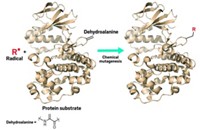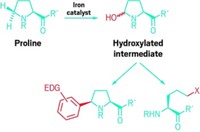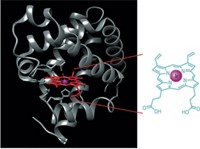Advertisement
Grab your lab coat. Let's get started
Welcome!
Welcome!
Create an account below to get 6 C&EN articles per month, receive newsletters and more - all free.
It seems this is your first time logging in online. Please enter the following information to continue.
As an ACS member you automatically get access to this site. All we need is few more details to create your reading experience.
Not you? Sign in with a different account.
Not you? Sign in with a different account.
ERROR 1
ERROR 1
ERROR 2
ERROR 2
ERROR 2
ERROR 2
ERROR 2
Password and Confirm password must match.
If you have an ACS member number, please enter it here so we can link this account to your membership. (optional)
ERROR 2
ACS values your privacy. By submitting your information, you are gaining access to C&EN and subscribing to our weekly newsletter. We use the information you provide to make your reading experience better, and we will never sell your data to third party members.
Biological Chemistry
Evolved enzymes help modify insulin’s amines
Strategy could precisely tweak protein drugs to improve their pharmacology
by Bethany Halford
June 16, 2022
As protein therapeutics continue to grow in popularity, chemists would like ways to precisely modify these complex biological molecules to improve their pharmacological properties. But proteins have a multitude of similar molecular motifs that can be hard to distinguish between. Now, researchers report a suite of evolved enzymes that can distinguish between insulin’s three primary amines—one at a lysine residue and two at the protein’s N-termini—allowing the scientists to selectively modify any one of those amines. Modified insulins could help reduce hypoglycemia and weight gain associated with the therapy.

The researchers, led by Merck & Co.’s Anna Fryszkowska and Chihui An, were inspired by the protecting groups chemists use to block certain species from reacting when making complex small molecules. They used directed evolution to engineer penicillin G acylase enzymes that selectively cap each of insulin’s amines. To produce the modified insulins, they apply these enzymatic caps, chemically modify the uncapped amine, and then remove the caps (Science 2022, DOI: 10.1126/science.abn2009).
Using this method, the researchers made stapled insulin dimers, such as MK-1092, which connects two insulin molecules together via a linker at the lysines’ amino groups. Previous attempts to make this dimer led to a complex mixture of products that had to be painstakingly separated.
Michael A. Weiss, a biochemist at Indiana University who works with insulin analogs and was not involved with the research, says the enzymatic strategy will make it possible to efficiently manufacture modified insulins at low-cost because it doesn’t give a mixture of products that must be separated. “It may lead in the future to a new generation of non-standard modified insulins,” Weiss says. “And the method is general and adaptable to other peptide targets.”
Fryszkowska says that while enzymes have been used to selectively distinguish between similar molecular motifs in small molecules, “this is one of the first examples where the same principle has been utilized for large biomolecules” like proteins. This work, she says, shows that “you can engineer that site selectivity of enzymes at will.”
Gonçalo Bernardes, a chemical biologist at the University of Cambridge and the Institute of Molecular Medicine, Lisbon, says that the enzymatic method will be useful for modifying insulin and similar peptides. But he adds that the method could be challenging to apply to larger proteins that have more lysine residues.
Fryszkowska says that the modified insulin is a relatively simple test case but that she and her coworkers would like to expand the strategy to more complex proteins and would like to work with enzymes that make new bonds directly instead of acting like protecting groups.





Join the conversation
Contact the reporter
Submit a Letter to the Editor for publication
Engage with us on Twitter